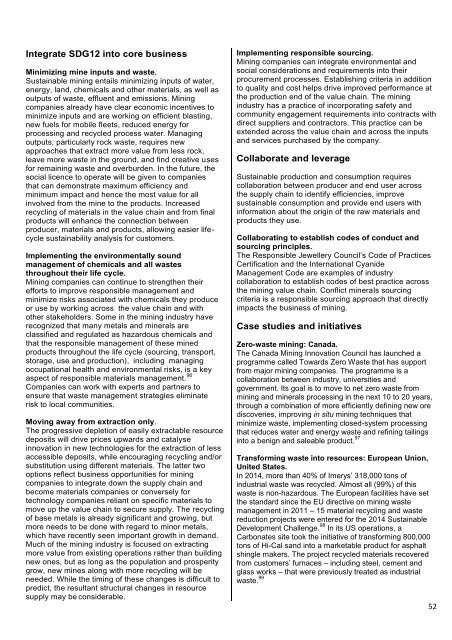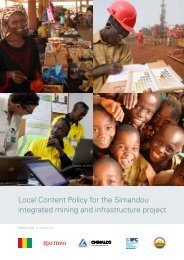Mapping Mining to the Sustainable Development Goals An Atlas
2gpArJN
2gpArJN
You also want an ePaper? Increase the reach of your titles
YUMPU automatically turns print PDFs into web optimized ePapers that Google loves.
Integrate SDG12 in<strong>to</strong> core business<br />
Minimizing mine inputs and waste.<br />
<strong>Sustainable</strong> mining entails minimizing inputs of water,<br />
energy, land, chemicals and o<strong>the</strong>r materials, as well as<br />
outputs of waste, effluent and emissions. <strong>Mining</strong><br />
companies already have clear economic incentives <strong>to</strong><br />
minimize inputs and are working on efficient blasting,<br />
new fuels for mobile fleets, reduced energy for<br />
processing and recycled process water. Managing<br />
outputs, particularly rock waste, requires new<br />
approaches that extract more value from less rock,<br />
leave more waste in <strong>the</strong> ground, and find creative uses<br />
for remaining waste and overburden. In <strong>the</strong> future, <strong>the</strong><br />
social licence <strong>to</strong> operate will be given <strong>to</strong> companies<br />
that can demonstrate maximum efficiency and<br />
minimum impact and hence <strong>the</strong> most value for all<br />
involved from <strong>the</strong> mine <strong>to</strong> <strong>the</strong> products. Increased<br />
recycling of materials in <strong>the</strong> value chain and from final<br />
products will enhance <strong>the</strong> connection between<br />
producer, materials and products, allowing easier lifecycle<br />
sustainability analysis for cus<strong>to</strong>mers.<br />
Implementing <strong>the</strong> environmentally sound<br />
management of chemicals and all wastes<br />
throughout <strong>the</strong>ir life cycle.<br />
<strong>Mining</strong> companies can continue <strong>to</strong> streng<strong>the</strong>n <strong>the</strong>ir<br />
efforts <strong>to</strong> improve responsible management and<br />
minimize risks associated with chemicals <strong>the</strong>y produce<br />
or use by working across <strong>the</strong> value chain and with<br />
o<strong>the</strong>r stakeholders. Some in <strong>the</strong> mining industry have<br />
recognized that many metals and minerals are<br />
classified and regulated as hazardous chemicals and<br />
that <strong>the</strong> responsible management of <strong>the</strong>se mined<br />
products throughout <strong>the</strong> life cycle (sourcing, transport,<br />
s<strong>to</strong>rage, use and production), including managing<br />
occupational health and environmental risks, is a key<br />
aspect of responsible materials management. 96<br />
Companies can work with experts and partners <strong>to</strong><br />
ensure that waste management strategies eliminate<br />
risk <strong>to</strong> local communities.<br />
Moving away from extraction only.<br />
The progressive depletion of easily extractable resource<br />
deposits will drive prices upwards and catalyse<br />
innovation in new technologies for <strong>the</strong> extraction of less<br />
accessible deposits, while encouraging recycling and/or<br />
substitution using different materials. The latter two<br />
options reflect business opportunities for mining<br />
companies <strong>to</strong> integrate down <strong>the</strong> supply chain and<br />
become materials companies or conversely for<br />
technology companies reliant on specific materials <strong>to</strong><br />
move up <strong>the</strong> value chain <strong>to</strong> secure supply. The recycling<br />
of base metals is already significant and growing, but<br />
more needs <strong>to</strong> be done with regard <strong>to</strong> minor metals,<br />
which have recently seen important growth in demand.<br />
Much of <strong>the</strong> mining industry is focused on extracting<br />
more value from existing operations ra<strong>the</strong>r than building<br />
new ones, but as long as <strong>the</strong> population and prosperity<br />
grow, new mines along with more recycling will be<br />
needed. While <strong>the</strong> timing of <strong>the</strong>se changes is difficult <strong>to</strong><br />
predict, <strong>the</strong> resultant structural changes in resource<br />
supply may be considerable.<br />
Implementing responsible sourcing.<br />
<strong>Mining</strong> companies can integrate environmental and<br />
social considerations and requirements in<strong>to</strong> <strong>the</strong>ir<br />
procurement processes. Establishing criteria in addition<br />
<strong>to</strong> quality and cost helps drive improved performance at<br />
<strong>the</strong> production end of <strong>the</strong> value chain. The mining<br />
industry has a practice of incorporating safety and<br />
community engagement requirements in<strong>to</strong> contracts with<br />
direct suppliers and contrac<strong>to</strong>rs. This practice can be<br />
extended across <strong>the</strong> value chain and across <strong>the</strong> inputs<br />
and services purchased by <strong>the</strong> company.<br />
Collaborate and leverage<br />
<strong>Sustainable</strong> production and consumption requires<br />
collaboration between producer and end user across<br />
<strong>the</strong> supply chain <strong>to</strong> identify efficiencies, improve<br />
sustainable consumption and provide end users with<br />
information about <strong>the</strong> origin of <strong>the</strong> raw materials and<br />
products <strong>the</strong>y use.<br />
Collaborating <strong>to</strong> establish codes of conduct and<br />
sourcing principles.<br />
The Responsible Jewellery Council’s Code of Practices<br />
Certification and <strong>the</strong> International Cyanide<br />
Management Code are examples of industry<br />
collaboration <strong>to</strong> establish codes of best practice across<br />
<strong>the</strong> mining value chain. Conflict minerals sourcing<br />
criteria is a responsible sourcing approach that directly<br />
impacts <strong>the</strong> business of mining.<br />
Case studies and initiatives<br />
Zero-waste mining: Canada.<br />
The Canada <strong>Mining</strong> Innovation Council has launched a<br />
programme called Towards Zero Waste that has support<br />
from major mining companies. The programme is a<br />
collaboration between industry, universities and<br />
government. Its goal is <strong>to</strong> move <strong>to</strong> net zero waste from<br />
mining and minerals processing in <strong>the</strong> next 10 <strong>to</strong> 20 years,<br />
through a combination of more efficiently defining new ore<br />
discoveries, improving in situ mining techniques that<br />
minimize waste, implementing closed-system processing<br />
that reduces water and energy waste and refining tailings<br />
in<strong>to</strong> a benign and saleable product. 97<br />
Transforming waste in<strong>to</strong> resources: European Union,<br />
United States.<br />
In 2014, more than 40% of Imerys’ 318,000 <strong>to</strong>ns of<br />
industrial waste was recycled. Almost all (99%) of this<br />
waste is non-hazardous. The European facilities have set<br />
<strong>the</strong> standard since <strong>the</strong> EU directive on mining waste<br />
management in 2011 – 15 material recycling and waste<br />
reduction projects were entered for <strong>the</strong> 2014 <strong>Sustainable</strong><br />
<strong>Development</strong> Challenge. 98 In its US operations, a<br />
Carbonates site <strong>to</strong>ok <strong>the</strong> initiative of transforming 800,000<br />
<strong>to</strong>ns of Hi-Cal sand in<strong>to</strong> a marketable product for asphalt<br />
shingle makers. The project recycled materials recovered<br />
from cus<strong>to</strong>mers’ furnaces – including steel, cement and<br />
glass works – that were previously treated as industrial<br />
waste. 99<br />
52






